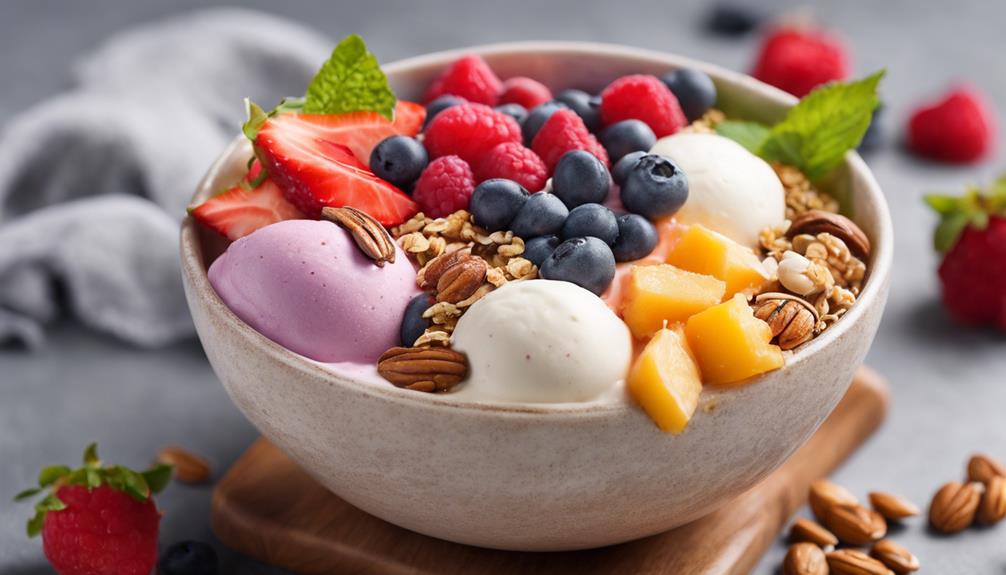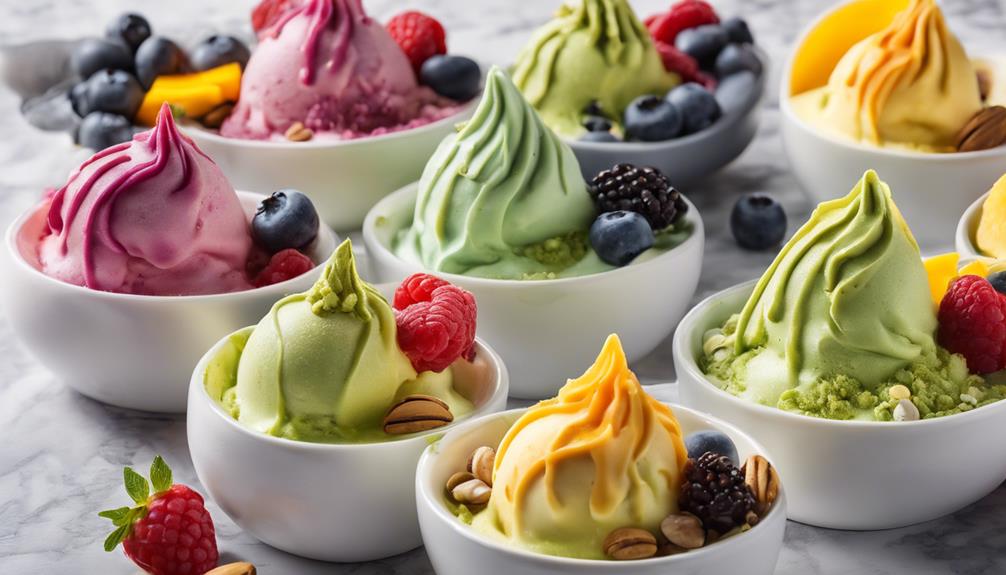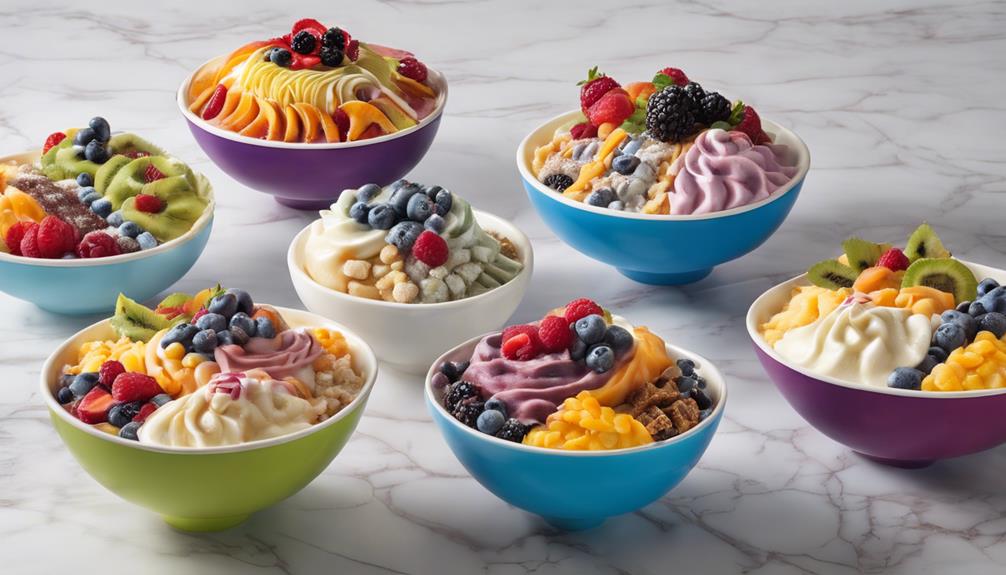Imagine the smooth, creamy texture of frozen yogurt, melting slowly on your tongue, delivering a perfect balance of tartness and sweetness. You might've wondered how this delightful treat manages to stay so light yet indulgent. By exploring the nutritional profile, production process, and ingredient composition, you'll uncover the science behind its health benefits and flavor variations. Ever thought about why some frozen yogurts taste richer while others are more tangy? Understanding the nuances can provide fascinating insights into consumer preferences and market trends. Ready to discover the secrets behind this versatile dessert?
Key Takeaways
- Frozen yogurt contains probiotics that enhance digestion and nutrient absorption.
- The low fat content of frozen yogurt makes it a healthier alternative to traditional ice cream.
- Key ingredients in frozen yogurt include milk fat, milk solids, yogurt culture, sweeteners, and stabilizers.
- Innovative flavor development in frozen yogurt addresses evolving consumer preferences and market demand.
- The production process of frozen yogurt involves pasteurization, homogenization, fermentation, cooling, and meticulous freezing.
Nutritional Profile

Frozen yogurt, often praised for its lower fat content compared to traditional ice cream, presents a nutritionally advantageous option for those seeking a healthier dessert alternative. A key factor contributing to its lower fat content is the reduced amount of milk fats utilized during production. Instead of high-fat cream, frozen yogurt formulations mainly contain milk solids, which include proteins, lactose, and minerals like calcium, but with much less fat.
When analyzing the nutritional profile, frozen yogurt typically contains about 0.5-2% fat, whereas traditional ice cream can contain upwards of 10-18% fat. This substantial reduction in fat content makes frozen yogurt a low-fat option, appealing to health-conscious consumers. Additionally, the inclusion of milk solids not only lowers the fat content but also enhances the nutritional value by providing essential nutrients.
Calcium, found abundantly in milk solids, is crucial for maintaining bone health. Also, the protein content in frozen yogurt, which can range from 3-5 grams per serving, aids in muscle repair and growth, contributing to a balanced diet. These nutritional attributes make frozen yogurt a compelling choice for those aiming to enjoy a tasty dessert without compromising on health benefits.
Production Process
Understanding the nutritional benefits of frozen yogurt necessitates examining the meticulous production process that guarantees its unique qualities. The cornerstone of this process is achieving the correct balance of ingredients—specifically, a minimum of 3.25% milk fat and 8.25% milk solids other than fat. This composition not only impacts the nutritional profile but also plays a vital role in determining the freezing point and texture of the final product.
The production process involves blending the ingredients followed by pasteurization. This is essential for eliminating any harmful bacteria. The mixture is then homogenized to ensure a consistent texture. Following this, the mixture is inoculated with live bacterial cultures and allowed to ferment. This fermentation step is pivotal for developing the characteristic tangy flavor of frozen yogurt.
Once fermentation is complete, the mixture is cooled and aged to enhance its viscosity and creaminess. The final step involves freezing, which must be meticulously controlled to achieve a smooth texture and prevent large ice crystal formation.
Here's a quick reference table summarizing key production parameters:
| Parameter | Requirement | Purpose |
|---|---|---|
| Milk Fat | ≥ 3.25% | Texture and mouthfeel |
| Milk Solids | ≥ 8.25% | Nutritional content |
| Weight per Gallon | ≥ 5 pounds | Consistency and creaminess |
These steps and parameters ensure frozen yogurt's unique taste, texture, and consistency, setting it apart from other frozen desserts.
Health Benefits

How does incorporating probiotics into your diet support gut health and overall wellness? Probiotics present in yogurt, including frozen varieties, promote a balanced microbiome by enhancing the population of beneficial bacteria in your gut. This can lead to improved digestion and bolstered immune function. Scientific studies show that probiotics can help manage conditions like irritable bowel syndrome (IBS) and reduce the incidence of gastrointestinal infections.
Frozen yogurt stands out as a healthier dessert option compared to ice cream due to its lower fat content. This makes it a preferable choice for those monitoring their fat intake while still desiring a sweet treat. Additionally, yogurt is a good source of calcium, which is crucial for maintaining bone health and strength. Regular consumption of calcium-rich foods like yogurt can help prevent osteoporosis and improve bone density.
Moreover, the protein content in frozen yogurt makes it a nutritious option for a snack or dessert. Protein is essential for muscle repair, growth, and overall bodily functions. Certain varieties of frozen yogurt contain live and active cultures, which further enhance digestion and nutrient absorption. Incorporating frozen yogurt into your diet can contribute significantly to your overall health and wellness.
Ingredient Composition
You'll find that the ingredient composition of frozen yogurt is critical to its texture and flavor profile. Primary dairy components like milk fat and milk solids are fundamental, while sweeteners and flavorings contribute greatly to taste. Stabilizers and emulsifiers are essential for maintaining consistency and preventing ice crystal formation.
Primary Dairy Components
Frozen yogurt's primary dairy components, including milk, sugar, and yogurt culture, form the foundation for its distinct texture and nutritional profile. Milk is the principal ingredient in frozen yogurt, contributing to its creamy consistency and providing essential nutrients such as calcium and protein. The type of milk used can vary; whole milk yields a richer texture, while skim milk offers a lighter, lower-fat alternative.
Yogurt culture, consisting of beneficial bacteria like Lactobacillus bulgaricus and Streptococcus thermophilus, is integral to frozen yogurt. These cultures ferment the milk, enhancing its probiotic content and aiding in digestion. The fermentation process also contributes to the tangy flavor characteristic of frozen yogurt.
Sugar serves multiple roles in frozen yogurt production. It not only sweetens the product but also lowers the freezing point, ensuring a smoother texture by preventing large ice crystal formation. The balance between these dairy components is essential for achieving the desired mouthfeel and nutritional benefits.
Sweeteners and Flavorings
In frozen yogurt formulations, alternative sweeteners like stevia, sucralose, and sorbitol are increasingly utilized to meet consumer demand for lower sugar content while maintaining flavor and texture. Traditionally, sucrose has been the go-to for sweetness, flavor, and consistency. However, the rising demand for healthier options necessitates reformulation strategies.
| Sweetener | Sweetness Level (relative to sucrose) | Common Usage in Frozen Yogurt |
|---|---|---|
| Stevia | 200-300 times sweeter | Natural, zero-calorie option |
| Sucralose | 600 times sweeter | Long shelf-life, stable |
| Sorbitol | 60% as sweet | Adds bulk, prevents crystallization |
Alternative sweeteners in frozen yogurt, such as stevia, offer a natural, zero-calorie solution, while sucralose provides a highly intense sweetness and a longer shelf-life. Sorbitol, though less sweet, is valuable for its bulking properties and ability to prevent crystallization.
Stabilizers and Emulsifiers
While alternative sweeteners are essential for meeting consumer health demands, the role of stabilizers and emulsifiers in frozen yogurt formulations is equally significant for maintaining ideal texture and consistency. Stabilizers such as guar gum, carrageenan, and xanthan gum are pivotal in preventing ice crystal formation, which is essential for achieving a smooth, creamy texture in frozen products. By controlling water mobility and viscosity, these agents guarantee that the frozen yogurt maintains its structural integrity even during storage and temperature fluctuations.
Emulsifiers like lecithin and mono- and diglycerides are indispensable in blending fats and water-based ingredients, contributing to a homogeneous mixture. The presence of emulsifiers enhances the creaminess and mouthfeel of the frozen yogurt, ensuring a consistent product quality. The synergy between stabilizers and emulsifiers is critical; an ideal balance not only prevents phase separation but also enhances the overall sensory attributes of the product.
Flavor Variations

With an expansive array of flavor variations, frozen yogurt caters to diverse palates by offering both traditional favorites and innovative seasonal options. This frozen dessert features classic flavors like vanilla, chocolate, and strawberry, which remain staples due to their broad appeal. However, the industry has expanded to include unique and exotic flavor variations such as mango, blueberry, and coconut, reflecting consumer demand for more diverse taste experiences.
Seasonal flavors are another significant aspect of frozen yogurt's appeal. Options like pumpkin spice in fall, peppermint in winter, and caramel apple during the holiday season demonstrate a strategic approach to flavor rotation, enhancing consumer engagement and marketability. Additionally, tart flavors like original tart, green tea, and pomegranate are widely appreciated for their distinct taste profiles, adding a level of sophistication to this frozen dessert.
Health-conscious consumers are not neglected, as sugar-free options and natural fruit flavors provide alternatives that align with dietary preferences. These variations help frozen yogurt remain a versatile and adaptable product within the frozen dessert category. By continually evolving its flavor offerings, the frozen yogurt industry successfully meets diverse consumer preferences, thereby sustaining its popularity and relevance in the market.
Market Trends
You'll notice a significant increase in consumer demand for frozen yogurt, driven largely by an interest in healthier dessert options. There's been a surge in flavor innovations, catering to a variety of tastes and preferences. Additionally, the market reflects a trend toward health-conscious choices, with low-fat and sugar-free options gaining popularity.
Growing Consumer Demand
The increasing consumer demand for healthier dessert options is driving significant growth in the global frozen yogurt market, as evidenced by rising sales of low-fat and sugar-free varieties. This trend is particularly noticeable among health-conscious individuals who view frozen yogurt as a superior alternative to traditional ice cream. The shift towards low-fat frozen yogurt aligns with broader dietary preferences aimed at reducing caloric intake while still enjoying a revitalizing treat.
Consumers are increasingly opting for frozen yogurt due to its nutritional benefits and versatility. Data indicates that regions with warmer climates exhibit higher consumption rates, highlighting frozen yogurt's appeal as a guilt-free indulgence in these areas. The market's growth trajectory can be attributed to several critical factors:
- Health Benefits: Low-fat and sugar-free frozen yogurt options cater to dietary requirements, offering a healthier dessert choice.
- Consumer Preferences: The variety of flavors and toppings available allows for customization, enhancing its appeal across different demographics.
- Market Availability: The proliferation of frozen yogurt shops and supermarket offerings has made it more accessible to a wider audience.
Flavor Innovation Surge
Leveraging innovative flavor development, the frozen yogurt market is responding to evolving consumer preferences by introducing new and exotic taste experiences that drive market differentiation and consumer engagement. This surge in flavor innovation is a strategic response to the competitive landscape, where traditional flavors are no longer sufficient to captivate a discerning audience.
Companies are proactively launching unique flavor combinations, seasonal offerings, and limited-edition releases to maintain consumer interest and excitement. These initiatives are not merely about novelty; they are grounded in extensive market research and consumer behavior analysis, guaranteeing that each new flavor aligns with current trends and preferences.
The emphasis on flavor innovation in frozen yogurt is evident in the diverse range of options now available, from tropical fruit blends to gourmet-inspired concoctions. This approach facilitates market differentiation and broadens the appeal of frozen yogurt to a wider demographic.
Data indicates that brands focusing on flavor innovation see increased consumer loyalty and higher engagement levels. The industry's dedication to creativity and freshness ensures that frozen yogurt remains a dynamic and appealing choice in the dessert market. As consumer tastes continue to evolve, flavor innovation will without a doubt remain a pivotal factor in the market's growth.
Health-Conscious Choices
Driven by its lower fat content and probiotic benefits, frozen yogurt has surged in popularity among health-conscious consumers seeking a guilt-free dessert option. The market for frozen yogurt is experiencing robust growth globally, fueled by an increasing demand for low-fat and sugar-free alternatives to traditional desserts. This trend is particularly noticeable in regions with warmer climates, where frozen yogurt serves as a invigorating and lighter dessert choice.
Key drivers contributing to this market expansion include:
- Nutritional Profile: Frozen yogurt is often marketed as a healthier option due to its lower fat content and status as a source of protein. Consumers are drawn to its probiotic benefits, which support gut health, and its calcium content, which is essential for bone health.
- Innovative Flavors and Textures: The introduction of new flavors and textures has broadened its appeal. Health-conscious consumers are keen on trying varieties that align with their dietary preferences, including sugar-free and high-protein options.
- Marketing Strategies: Effective marketing campaigns emphasize the health benefits of frozen yogurt, positioning it as a guilt-free treat that doesn't compromise on taste. This aligns with broader consumer trends towards functional foods that offer additional health benefits.
Frequently Asked Questions
What Is the Concept of Frozen Yogurt?
You're exploring frozen yogurt's concept, highlighting its cultural significance and flavor variations. This dessert boasts probiotics, lower fat, and diverse flavors, making it a popular, healthier alternative to ice cream with notable nutritional benefits.
What Is the Science Behind Yogurt?
You're asking about the science behind yogurt. It involves the fermentation process where bacterial cultures convert lactose into lactic acid, creating a tangy flavor and creamy texture. This process supports gut health through probiotics.
What Bacteria Is in Frozen Yogurt?
You won't believe how beneficial these bacterial strains in frozen yogurt are! Probiotic benefits from Lactobacillus bulgaricus, Streptococcus thermophilus, and Bifidobacterium lactis greatly enhance gut health and digestion, distinguishing frozen yogurt from traditional ice cream.
Is Frozen Yogurt Actually Healthy?
Frozen yogurt's nutritional benefits depend on its ingredients. It generally has a lower calorie count than ice cream, and probiotics can enhance gut health. However, added sugars and artificial flavors may diminish its overall healthiness.
Conclusion
Immerse yourself in the world of frozen yogurt and discover how it revolutionizes your dessert game! With its unparalleled low-fat content, jaw-droppingly high protein levels, and mind-blowing probiotic benefits, this isn't just a treat—it's a nutritional powerhouse. The sophisticated production process, groundbreaking ingredient composition, and dizzying array of flavor variations make frozen yogurt the ultimate indulgence. Market trends scream one thing: consumers' insatiable hunger for healthier, customizable desserts is met head-on by this miraculous creation. Explore the future of desserts with frozen yogurt!







